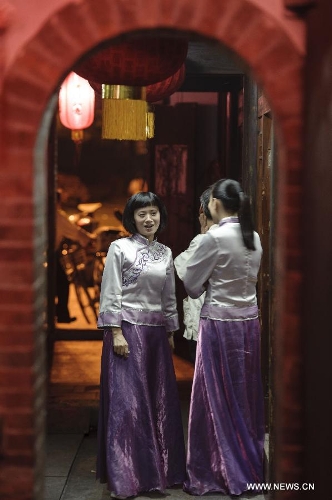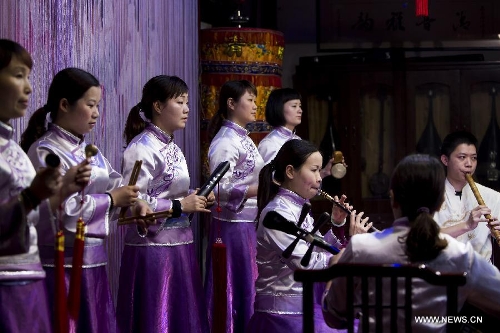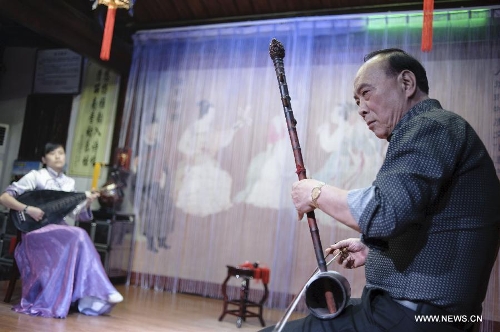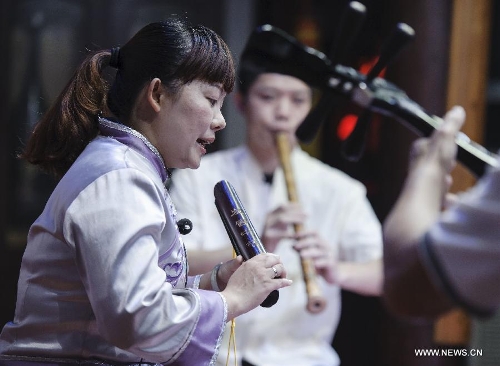Nanyin: Ancient Chinese folk music originated from Fujian

Audience enjoy the performance of Nanyin, an ancient Chinese folk music art form originated from southeast China's Fujian Province, at a tea house in Quanzhou, Fujian Province, May 8, 2014. Nanyin, known as the "living fossil" of ancient Chinese music, literally means music in the south and is a traditional opera in Fujian dialect. Nanyin was spread to Southeast Asia and also introduced to Europe and America by thousands of overseas Chinese, when the Maritime Silk Road flourished during ancient China's Song(960-1279) and Yuan(1271-1368) Dynasties. In 2006, Nanyin was enlisted as a National Non-material Cultural Heritage. Three years later, it was listed as a World Human Verbal and Intangible Cultural Heritage by UNESCO. (Xinhua/Shen Bohan)

An elder enjoys the performance of Nanyin, an ancient Chinese folk music art form originated from southeast China's Fujian Province, at a tea house in Quanzhou, Fujian Province, May 8, 2014. Nanyin, known as the "living fossil" of ancient Chinese music, literally means music in the south and is a traditional opera in Fujian dialect. Nanyin was spread to Southeast Asia and also introduced to Europe and America by thousands of overseas Chinese, when the Maritime Silk Road flourished during ancient China's Song(960-1279) and Yuan(1271-1368) Dynasties. In 2006, Nanyin was enlisted as a National Non-material Cultural Heritage. Three years later, it was listed as a World Human Verbal and Intangible Cultural Heritage by UNESCO. (Xinhua/Shen Bohan)

Audience enjoy the performance of Nanyin, an ancient Chinese folk music art form originated from southeast China's Fujian Province, at a tea house in Quanzhou, Fujian Province, May 8, 2014. Nanyin, known as the "living fossil" of ancient Chinese music, literally means music in the south and is a traditional opera in Fujian dialect. Nanyin was spread to Southeast Asia and also introduced to Europe and America by thousands of overseas Chinese, when the Maritime Silk Road flourished during ancient China's Song(960-1279) and Yuan(1271-1368) Dynasties. In 2006, Nanyin was enlisted as a National Non-material Cultural Heritage. Three years later, it was listed as a World Human Verbal and Intangible Cultural Heritage by UNESCO. (Xinhua/Shen Bohan)

A singer performs Nanyin, an ancient Chinese folk music art form originated from southeast China's Fujian Province, at a tea house in Quanzhou, Fujian Province, May 9, 2014. Nanyin, known as the "living fossil" of ancient Chinese music, literally means music in the south and is a traditional opera in Fujian dialect. Nanyin was spread to Southeast Asia and also introduced to Europe and America by thousands of overseas Chinese, when the Maritime Silk Road flourished during ancient China's Song(960-1279) and Yuan(1271-1368) Dynasties. In 2006, Nanyin was enlisted as a National Non-material Cultural Heritage. Three years later, it was listed as a World Human Verbal and Intangible Cultural Heritage by UNESCO. (Xinhua/Jiang Kehong)

Performers of Nanyin, an ancient Chinese folk music art form originated from southeast China's Fujian Province, take a rest at a tea house in Quanzhou, Fujian Province, May 8, 2014. Nanyin, known as the "living fossil" of ancient Chinese music, literally means music in the south and is a traditional opera in Fujian dialect. Nanyin was spread to Southeast Asia and also introduced to Europe and America by thousands of overseas Chinese, when the Maritime Silk Road flourished during ancient China's Song(960-1279) and Yuan(1271-1368) Dynasties. In 2006, Nanyin was enlisted as a National Non-material Cultural Heritage. Three years later, it was listed as a World Human Verbal and Intangible Cultural Heritage by UNESCO. (Xinhua/Jiang Kehong)

Performers of Nanyin, an ancient Chinese folk music art form originated from southeast China's Fujian Province, chat with each other at a tea house in Quanzhou, Fujian Province, May 8, 2014. Nanyin, known as the "living fossil" of ancient Chinese music, literally means music in the south and is a traditional opera in Fujian dialect. Nanyin was spread to Southeast Asia and also introduced to Europe and America by thousands of overseas Chinese, when the Maritime Silk Road flourished during ancient China's Song(960-1279) and Yuan(1271-1368) Dynasties. In 2006, Nanyin was enlisted as a National Non-material Cultural Heritage. Three years later, it was listed as a World Human Verbal and Intangible Cultural Heritage by UNESCO. (Xinhua/Jiang Kehong)

Tourists enjoy the performance of Nanyin, an ancient Chinese folk music art form originated from southeast China's Fujian Province, at a tea house in Quanzhou, Fujian Province, May 8, 2014. Nanyin, known as the "living fossil" of ancient Chinese music, literally means music in the south and is a traditional opera in Fujian dialect. Nanyin was spread to Southeast Asia and also introduced to Europe and America by thousands of overseas Chinese, when the Maritime Silk Road flourished during ancient China's Song(960-1279) and Yuan(1271-1368) Dynasties. In 2006, Nanyin was enlisted as a National Non-material Cultural Heritage. Three years later, it was listed as a World Human Verbal and Intangible Cultural Heritage by UNESCO. (Xinhua/Jiang Kehong)

Performers of Nanyin, an ancient Chinese folk music art form originated from southeast China's Fujian Province, stage at a tea house in Quanzhou, Fujian Province, May 8, 2014. Nanyin, known as the "living fossil" of ancient Chinese music, literally means music in the south and is a traditional opera in Fujian dialect. Nanyin was spread to Southeast Asia and also introduced to Europe and America by thousands of overseas Chinese, when the Maritime Silk Road flourished during ancient China's Song(960-1279) and Yuan(1271-1368) Dynasties. In 2006, Nanyin was enlisted as a National Non-material Cultural Heritage. Three years later, it was listed as a World Human Verbal and Intangible Cultural Heritage by UNESCO. (Xinhua/Shen Bohan)

Xia Yongxi(R), an inheritor of Nanyin, an ancient Chinese folk music art form originated from southeast China's Fujian Province, plays erxian, a two-stringed instrument, at a tea house in Quanzhou, Fujian Province, May 8, 2014. Nanyin, known as the "living fossil" of ancient Chinese music, literally means music in the south and is a traditional opera in Fujian dialect. Nanyin was spread to Southeast Asia and also introduced to Europe and America by thousands of overseas Chinese, when the Maritime Silk Road flourished during ancient China's Song(960-1279) and Yuan(1271-1368) Dynasties. In 2006, Nanyin was enlisted as a National Non-material Cultural Heritage. Three years later, it was listed as a World Human Verbal and Intangible Cultural Heritage by UNESCO. (Xinhua/Jiang Kehong)

Performers of Nanyin, an ancient Chinese folk music art form originated from southeast China's Fujian Province, stage at a tea house in Quanzhou, Fujian Province, May 8, 2014. Nanyin, known as the "living fossil" of ancient Chinese music, literally means music in the south and is a traditional opera in Fujian dialect. Nanyin was spread to Southeast Asia and also introduced to Europe and America by thousands of overseas Chinese, when the Maritime Silk Road flourished during ancient China's Song(960-1279) and Yuan(1271-1368) Dynasties. In 2006, Nanyin was enlisted as a National Non-material Cultural Heritage. Three years later, it was listed as a World Human Verbal and Intangible Cultural Heritage by UNESCO. (Xinhua/Jiang Kehong)